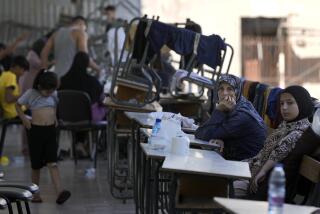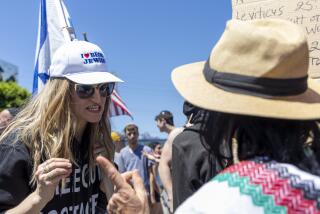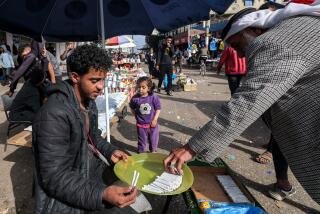In Jerusalem’s Old City, Muslim Quarter faces overcrowding woes
- Share via
JERUSALEM — Beyond the Old City’s Jewish Quarter, with its picturesque flower boxes and blue-and-white Israeli flags, past the devout Christian tourist groups laboring up the Via Dolorosa, the 13 members of the Sidawi family share a dank 250-square-foot room with just one tiny window.
Living in the Old City’s Muslim Quarter, by far the most densely populated area in Jerusalem, the family has learned to do everything in shifts: using the bathroom, eating, studying and even sleeping. Except for two narrow cots, their home is empty of furniture, which makes it easier at night when family members lie down head to toe on blankets on the floor.
“There’s never a moment alone anymore,” said janitor Ribhi Sidawi, 52.
Fueled by Israel’s construction of the separation wall here and a rush of Arabs back to eastern Jerusalem, a population boom in the Muslim Quarter is turning this corner of the Old City into what residents say has become a large slum.
Thousands of Jerusalem-born Arabs who fled for more comfortable lives in nearby West Bank villages have returned since Israel began revoking Jerusalem residency cards — and the government healthcare and welfare benefits they carry — of those living outside the municipal border. Others are seeking to avoid the daily hassle of the wall’s security checkpoints.
The overcrowding is a side effect of the larger demographic battle between Jews and Palestinians over control of Jerusalem, a city both see as their rightful capital.
Critics say Israel is trying to make life unbearable for Arabs to drive them out. Israeli officials counter that they are trying to improve services and infrastructure. No one is forcing Arabs to return, they say, and the government should not have to provide benefits to those living in the West Bank.
The Muslim Quarter’s poorest neighborhoods are a part of the ancient walled city that most visitors never see, a place where romantic stone streets and vibrant, spice-scented markets give way to graffiti-covered walls and the stench of sewage and garbage rotting under the sun.
The unemployment rate runs above 30%, and 3 out of 4 children in the Muslim Quarter live below the poverty line, according to the Palestinian advocacy group International Peace and Cooperation Center.
Returning families are making homes out of old barns, basements, terraces, empty water cisterns and vacant shops. They are enclosing balconies, covering rooftops, building lofts and extending walls into courtyards and sidewalks to make more room.
In some of the poorest neighborhoods, such as Bab Hutta, tangles of electricity lines and water pipes snake around buildings, over grime-covered streets and up stairwells. Many of the walls and roofs are cobbled together using scrap metal, green plastic sheeting, burlap sacks and plywood.
Just steps from a gate to Al Aqsa Mosque, the Hubash family enclosed a rooftop deck to accommodate a grown son and his family. But city inspectors ordered the new roof dismantled and fined the family $7,000 for building without a permit, said Bahyeh Hubash, 65. Her son’s family still lives on the roof, but during winter and rain the children huddle downstairs.
“How are we supposed to live like this?” she asked, pointing to the half-destroyed roof. “The city never helps us. They only know how to tear things down.”
Unemployed carpenter Abdul Mutalab Asmar, 47, escaped the Muslim Quarter a decade ago when he built a spacious home in the Palestinian village of Al Ram and opened a furniture shop to support his family of nine.
But the threat of losing his residency card sent everyone rushing back into a one-room apartment here, and he had to close the store.
The population of the Muslim Quarter has doubled to 31,182 over the last 30 years, rising 17% from 2007 to 2010, according to government figures. The 400 people per acre in the district, in the Old City’s northeastern corner, is four times the density of the Jewish Quarter and 16 times that of Jerusalem overall.
“It may be the most densely populated area in the Middle East,” said Israel Kimhi, planning director of the Jerusalem Institute for Israel Studies. “It’s unbelievable. If you want to disappear and be anonymous, that’s the place to go. No one will find you.”
The city hasn’t opened an elementary school in the Muslim Quarter since Israel took control of East Jerusalem during the 1967 war, leaving it with the same two facilities that existed under Jordanian rule. Although some private religious schools have opened, even they have begun turning away children because of lack of space.
At Mawlawjeh, one of the two city schools, enrollment has increased more than 40% over the last decade to 1,000 students, said Maha Ghoul, who retired this year as principal after 42 years. With 45 students per class, the school now needs two teachers per room and lessons are conducted in the hallways, she said.
Jerusalem Mayor Nir Barkat declined to comment, but he has said that improving services for Arab residents is a top priority. City officials say they have invested heavily over the last two years in the Muslim Quarter, hiring a new $350,000-a-month garbage collection service, opening a new recreation center and spending $7.5 million on roads and other infrastructure, city spokesman Barak Cohen said.
Such improvements are a factor in the population increase, he said.
“There are more people living in the Old City today because it’s an increasingly desirable place to live,” Cohen said in a statement.
A separate state-funded task force is preparing to invest nearly $14 million to alleviate Old City crowding by repairing roads and walls, renovating classrooms and improving city services, said planner Kimhi, who is part of the committee.
But he said a more permanent solution is to build new housing for low-income Arabs in other parts of the city to reduce Old City congestion. Despite promises to alleviate the housing crunch, the most recent major effort to develop housing for Arabs in Jerusalem was in the 1980s, he said.
Critics note that tens of thousands of new housing units have been built in the Jerusalem area for Jewish families in the last 30 years.
The surge in population is not helping business, shopkeepers complain, because most of the residents are poor. Israel’s 30-foot-tall separation wall around Jerusalem has prevented West Bank residents from doing their weekly shopping in the Old City as they once did.
“More people? Yes,” said butcher Ayman Badriyeh, 60, as his blood-caked fingers made fast work trimming fat from a leg of beef. “More money? No.”
“Look there,” he said, waving a knife at shuttered storefronts across the road. “Five shops. All closed because no one shops here anymore.”
Though police say crime rates are steady, there is a rise in tempers and neighborhood disputes, particularly over property, rents and renovations. Some of the biggest property-owning families recently created a community committee to mediate disputes.
“The flood of people is changing the character,” said Yasser Qous, manager at African Community Society, which assists immigrants in the Old City. “When I was growing up, I knew everyone in the Muslim Quarter. Now I don’t even know my neighbors.”
One place that seems to be thriving is the soup kitchen that claims it has been operating continuously for nearly 500 years in the basement of an old Arab mansion.
The number of hungry people served is twice that of a decade ago, said Ahmed Bheis, the kitchen’s director.
“From what I see, the poverty just gets worse every year,” Bheis said, standing over a simmering vat of chicken noodle soup. “And the numbers here just keep growing.”
More to Read
Sign up for Essential California
The most important California stories and recommendations in your inbox every morning.
You may occasionally receive promotional content from the Los Angeles Times.










